If you want to know the average thigh circumference for men, women, teenagers, and bodybuilders, then you’re in the right place.
Our research draws on real-life anthropometric data—conveniently displayed in thigh circumference charts—so that you can also learn the average thigh size for your age.
Additionally, you’ll discover how to measure your thighs the right way so that you can get the most accurate measurement and see how your legs stack up.
- 14 inch thighs
- 17 inch thighs
- 18 inch thighs
- 19 inch thighs
- 20 inch thighs
- 21 inch thighs
- 22 inch thighs
- 23 inch thighs
- 24 inch thighs
- 25 inch thighs
- 26 inch thighs
- 27 inch thighs
- 28 inch thighs
- 29 inch thighs
- 30 inch thighs
- 32 inch thighs
- 34 inch thighs
- 35 inch thighs
- 40 inch thighs
What is the average male thigh size?

Based on 2008 anthropometric reference data from the CDC that examined 4,255 participants, the average male thigh size across all ages is 21.2 inches or 53.8 cm. [1]
As you might expect, certain groups of men have bigger thighs than others. For example, men aged 20-29 had 20.8 inch thighs on average, whereas men aged 30 to 39 had 21.3 inch thighs.
According to the research, male thigh size peaks at 21.4 inches when a man is between the ages of 40 and 49. We’ll explore the reasons for this in the upcoming thigh size chart section.
After a man hits middle age, the average male thigh circumference decreases to 20.9 inches between the ages of 50 and 59 and 20.6 inches between the ages of 60 and 69.
From there, the measurements decrease further still, reaching 19.5 inches between the ages of 70 and 79. Finally, men aged 80+ have 18.7 inch thighs on average.
What is the average female thigh size?

According to a National Health and Nutrition Examination Survey conducted by the National Center for Health Statistics, the average female thigh circumference is 20.8 inches or 52.9 cm. This is based on a sample size of 4,065 women.
As with the male statistics, the average female thigh size increases and decreases depending on your age, but to a lesser extent.
Women aged 20-29, 30-39, and 40-49 all had 21.7 inch thighs on average, which is right around the ideal female thigh size that many women want to obtain.
Like that of men, the average thigh circumference for females tends to decrease after the age of 50. For example, women between the ages of 50-59 had 20.9 inch thighs—the same as their male peers.
Once a woman reaches the age of 70, her thigh measurement typically decreases to around 19.7 inches. In her 80s, the average woman can expect to have 18.3 inch thighs.
Related: Average calf size│Average waist measurement
What is the average thigh size for a teenage girl?
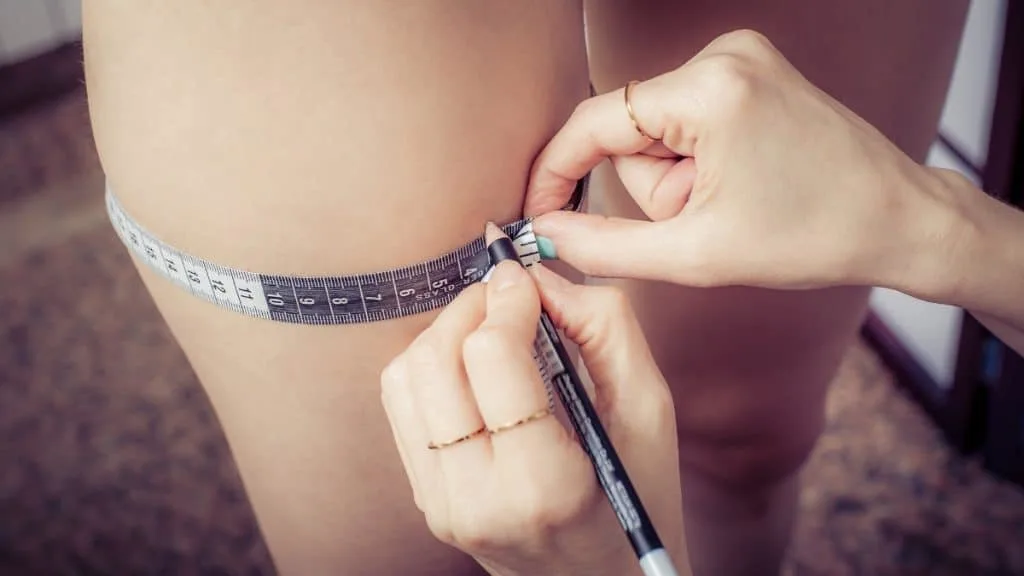
The average thigh circumference measurement for girls greatly depends on the age of the child, which you will see for yourself on the charts below.
Based on the data, however, one thing that’s clear is that female thigh measurements increase at every age from 8 to 19.
This information is helpful for both parents and health practitioners to determine if a girl is growing and developing at the ideal rate.
What is the average thigh size for a teenage boy?

The average leg circumference for a boy is actually very similar to that of a girl. It also differs significantly depending on the age of the boy.
For example, up until the age of 13, the average boy actually has smaller thighs than the average girl. This is likely due to the fact that most girls begin puberty before boys. [2]
Once a boy gets well into his teenage years, however, his mid thigh measurement will typically be a bit larger than that of his female peers.
Still, as you can see on the charts below, the difference isn’t as significant as many people would assume.
Related: Average shoulder width│ Average BMI
What is the average quad size?

The average male quad size for a man who lifts weights on a weekly basis is between 23 and 24 inches. Those who are seriously into bodybuilding typically have a quad measurement of 25 inches or slightly greater.
As you can imagine, there isn’t any good data that examines the average quad size in bodybuilders.
However, based on years of observation and measurement taking, it’s quite clear that the average male lifter has between 23 and 24 inch thighs.
Serious female weight lifters tend to have a similar, if slightly smaller, thigh width measurement to that of their male peers (22-24 inches is typical for women who train their legs directly).
Of course, the more body fat that you have, the bigger your legs will be.
Additionally, just because your measurement falls an inch or two outside of the average doesn’t mean that you don’t have a normal thigh size or a healthy thigh circumference.
Other factors such as your height, build, and training experience all affect what’s considered normal sized thighs.
Male thigh circumference chart
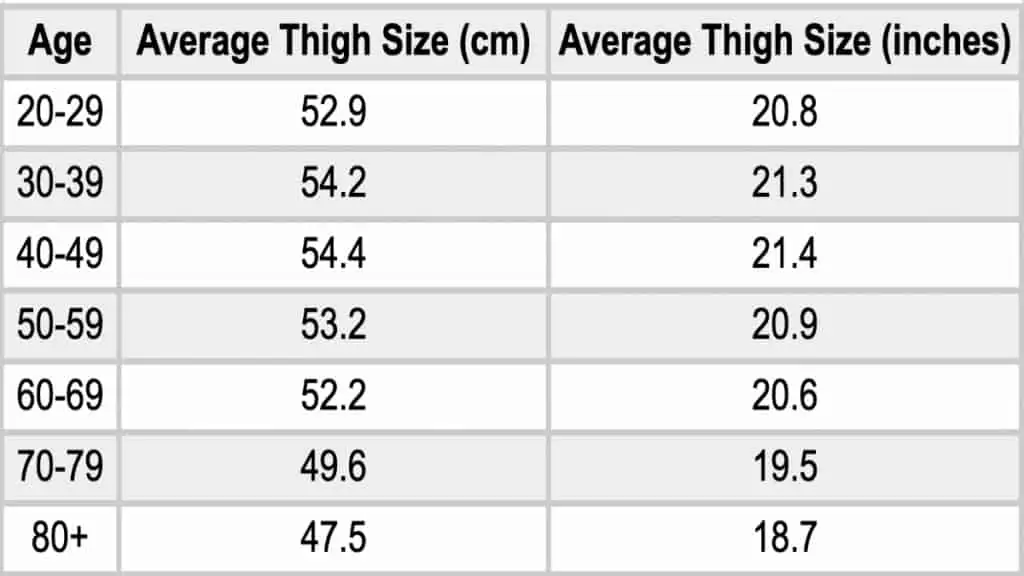
It’s interesting to see that the average male thigh size typically peaks at middle age rather than in a man’s 20s and 30s.
This may be because older men are less active than younger men, or it may be that the younger participants in the study actually lacked muscle mass compared to the older men.
Between the ages of 50 and 69, the average leg circumference for a man only decreases by 0.3 inches. This is an indication that men don’t lose much muscle mass until they reach their 70s.
Once a man does get into his 70s, he can expect to lose around an inch of thigh mass. This process is called sarcopenia, and it can be minimized by performing resistance training. [3]
The average thigh measurement for a man in his 80s is 18.7 inches.
See Also: Average biceps size│Average neck size
Female thigh size chart

The average female thigh circumference is much more consistent across the ages than that of men.
Based on the above-cited research, which examined 4,065 participants, women aged 20-49 all tend to have 21.7 inch thighs on average.
This is actually a bigger thigh measurement than that of equivalent aged men and may be due to the fact that females tend to store more fat on their legs than males.
This thigh circumference measurement decreases significantly (by 0.8 inches) once a woman gets into her 50s.
From this point, female thigh measurements decrease by another half-inch to 20.4 inches once a woman reaches her 60s.
As a woman gets into her 70s, age-related muscle loss becomes more apparent because a normal thigh circumference for a woman aged 70-79 is 19.7 inches.
For women aged 80+, this measurement decreases even more to an average of just 18.3 inches.
Adolescent thigh measurement chart (girls)
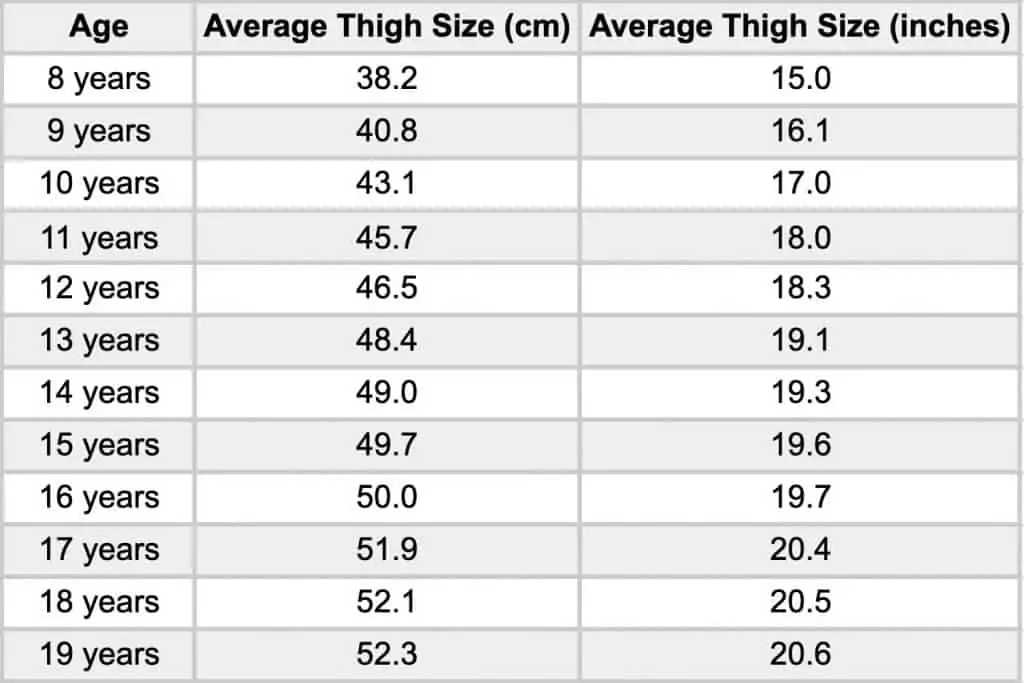
Since girls typically begin puberty before boys, it’s not surprising that they have more developed thighs from the ages of 9-13.
While adolescent girls do have smaller thighs on average once their male peers reach puberty, the difference isn’t as significant as some people may believe.
For example, there’s only a 0.6 inch difference in thigh measurement (20.4 inches vs 21 inches) between 17-year-old girls and 17-year-old boys.
Related: Average hip size for women│Average butt size
Adolescent thigh size chart (boys)

Although boys and girls aged 8-19 have similarly sized thighs throughout their development, girls aged 9-13 actually have bigger thighs on average than their male peers.
This is likely because males haven’t gone through puberty at this age and thus haven’t had the chance to accumulate muscle mass.
Aged 14 onwards, adolescent boys consistently have a larger thigh circumference measurement than their female peers. For example, a 19-year-old adolescent male typically has thighs that are a full inch larger than those of his female peers.
How to measure your thighs

Learning how to measure your thigh circumference can help you to track your resistance training and weight loss progress.
If you’re a parent, carer, or health professional, understanding how to measure thigh circumference accurately can help you to gauge the development and health status of your child, relative, or patient.
- Stand up straight with the skin of your thigh exposed.
- Wrap a tape measure around the thickest part of your thigh. This will typically be between the mid and upper thigh for most people.
- Record the number where the two ends of the tape begin to overlap. This is your thigh circumference measurement.
- Repeat the process another 1-2 times to ensure that your measurement is as accurate as possible.
Thigh circumference FAQ
Learn the average thigh size for various ages, heights, physique goals, and much more by reading this helpful FAQ.
Where should you measure your thighs?
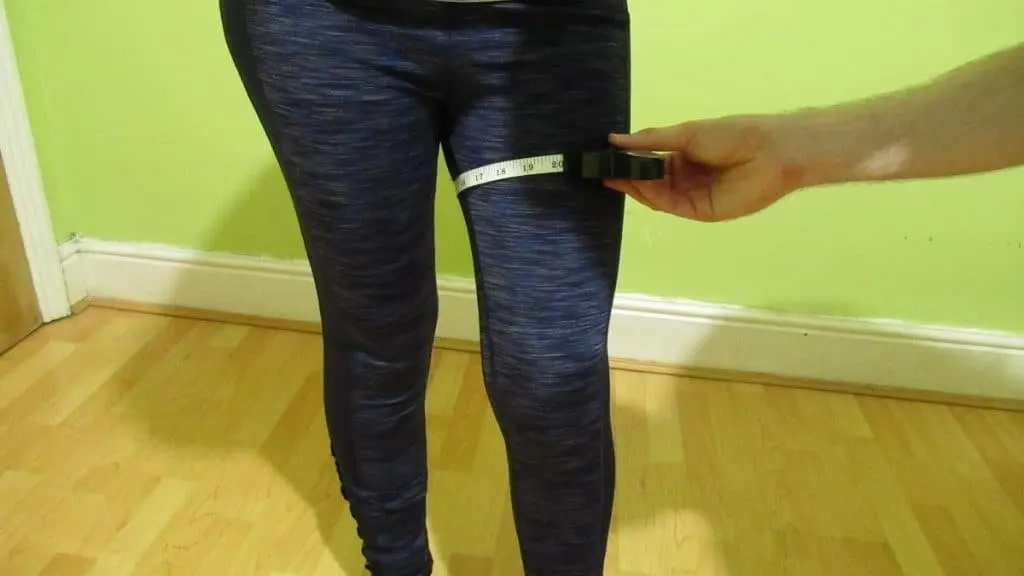
Understanding where to measure your thighs is crucial for the consistency and accuracy of your measurements.
If you measure your legs at different points throughout the months and years, then you’ll get inaccurate data and may think that you’ve lost/gained more muscle/fat than you really have.
So, where should you measure your thighs?
Ideally, you should measure your thighs at their thickest point. For most individuals, this will be somewhere between the mid and upper thigh.
You can easily locate the thickest part of your thigh by slowly sliding the tape measure up and down your leg.
How big should my thighs be for my height?

While there is no actual research exploring the relationship between height and thigh size, everyday observation will tell you that tall people tend to have slimmer thighs than shorter people.
One reason for this could be the fact that if a tall person and a short person both have the same amount of thigh mass, the muscle mass of the tall person will naturally be stretched over a longer surface area and thus appear smaller.
Of course, there are plenty of examples of tall people with monstrous thighs (Brian Shaw, anyone?), so there’s no hard and fast rule that says your height has to affect your thigh size.
What is the average thigh size for a 16-year old male?

According to 2008 anthropometric data from a National Health Statistics Report, the average thigh size for a 16-year-old male is 21.1 inches. This is based on a sample size of 302 boys.
There were, of course, a number of outliers who had thighs that were bigger and smaller. This could be due to resistance training, obesity, or genetic thigh muscularity.
Nevertheless, this data is useful for gauging how you or your son’s physical development compares to that of his peers.
What is a good thigh measurement for models?

Ideal model thigh measurements vary based on the type of modeling you are doing or would like to partake in.
For fashion modeling, it appears that a thigh measurement of 20 inches or below is typical. This number may be smaller if you’re tall and slightly bigger if you’re on the shorter side.
On the other hand, a male fitness model would need considerably larger thighs, likely around 25 inches.
Of course, it’s of paramount importance that you don’t harm your health when trying to achieve a specific modeling look. [4]
Just because you may not have the “ideal” proportions for one type of modeling doesn’t mean that you can’t succeed in other areas of modeling.
What is considered medium sized thighs?
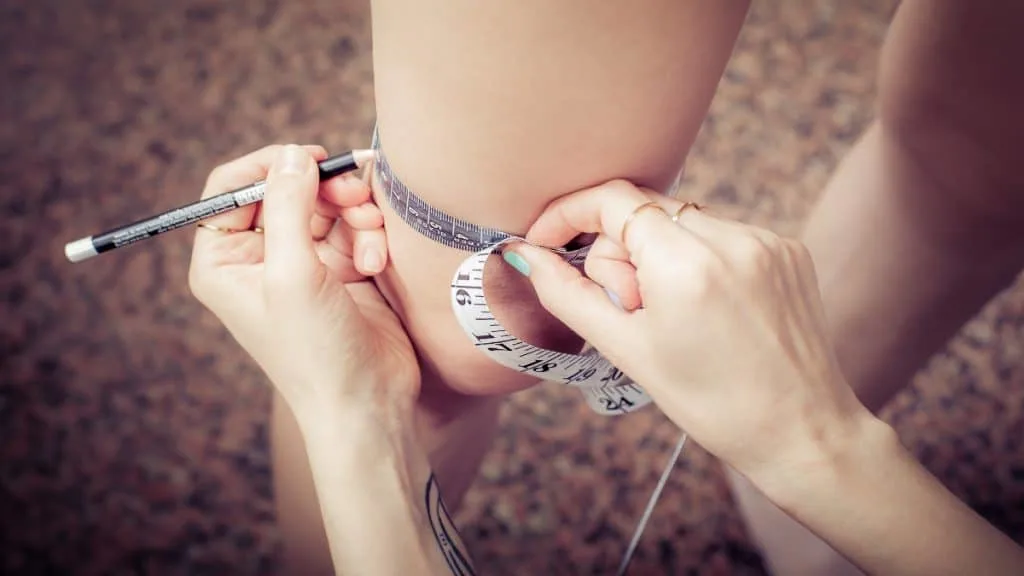
Based on the previously cited CDC report, medium sized thighs, which is to say the average leg circumference, tends to be around 21 inches in both men and women.
In terms of a range, thighs sized between 21 and 23 inches are considered medium by most people.
If your thighs are slightly bigger than this, then that doesn’t necessarily mean that they’re too big.
Indeed, some research suggests that having excessively small thighs is associated with health problems like heart disease. [5]
Is there such thing as a perfect thigh measurement?
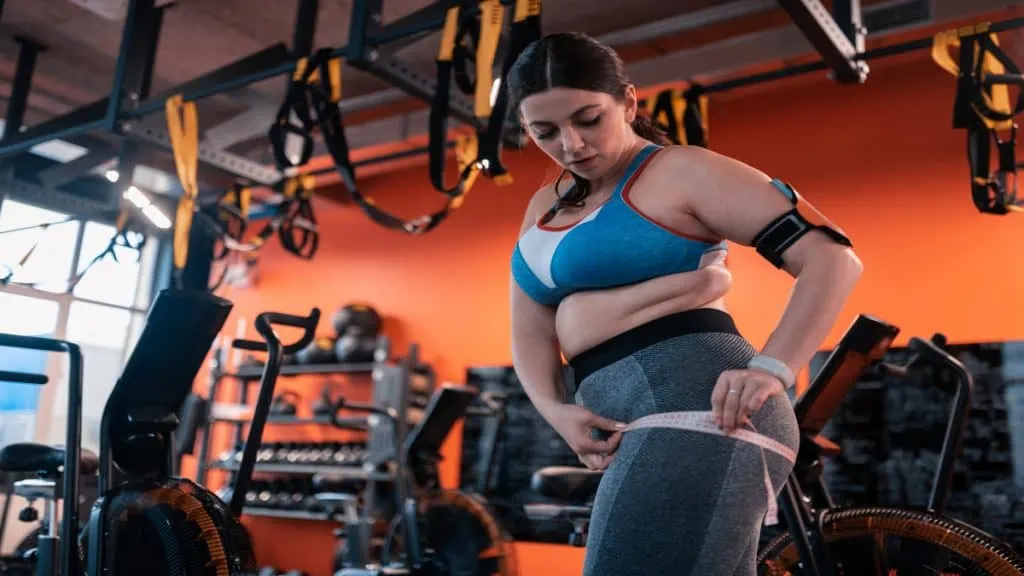
In terms of aesthetics, there’s no such thing as the ideal thigh size because each person has their own vision of what constitutes perfect thighs.
Of course, there may be a general consensus among certain groups of people that having larger or smaller thighs is preferable. Models, for example, may prefer smaller thighs, whereas bodybuilders would obviously find bigger thighs more desirable.
Additionally, as explained by Harvard Health Publishing, some Danish research suggests that 24 inch thighs are most protective against heart disease and premature death. [6]
This could be because muscular thighs are associated with an active lifestyle, and being stronger can increase your life expectancy. [7]
What is the ideal thigh size for a 5’2 female?

There is no precise or ideal thigh size for a 5’2 female because health isn’t measured by inches on the tape. However, a range of 19 to 22 inches is likely ideal in the sense that a woman with thighs this size is unlikely to be overweight.
How do you measure your legs for bodybuilding?
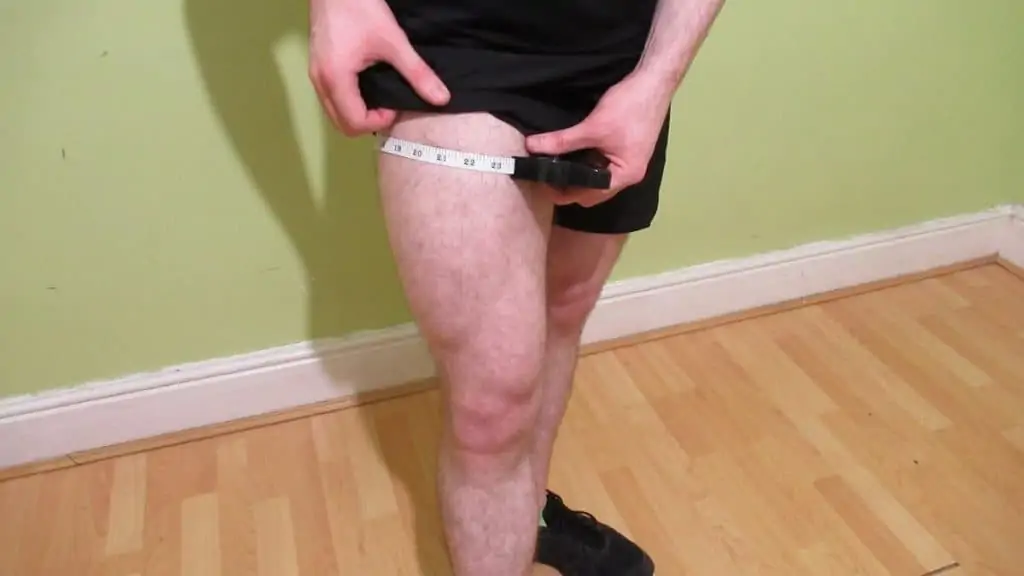
Measuring your thighs accurately will help you to track the effectiveness of your bodybuilding training.
So whether you’re training to build the world’s biggest thighs or just to get in shape, it’s important to take an accurate thigh circumference measurement.
Measuring your quads, both pumped or unpumped, is fine as long as you measure them in the same state in the future.
For example, if you measure your quads cold today and then pumped in a month, then you might be fooled into thinking that you’ve gained muscle mass when, in reality, you just have a pump from your workout.
There is, of course, nothing wrong with comparing your pumped and unpumped measurements. Just make sure to measure your legs in the same state if you want to track your progress properly.
Virtually all of the quad measurements that you see online are taken cold. It doesn’t matter that much if the measurement is taken flexed or unflexed.
Also, make sure to measure your quads around the thickest part, which is typically around the mid and upper thigh area.
Read More: Average forearm size│Average male chest size
Conclusion: How big should your thighs be?

So, how big should your thighs be?
As you saw in the article, the ideal thigh size for males and females primarily depends on your age.
According to the research, the average thigh circumference is slightly larger in young women than in young men. It’s only when a woman reaches her 80s that her thigh size declines well below that of men her age.
Of course, there is also research that suggests that having larger thighs is beneficial for your health.
This may well be the case, or it could just be an indicator of an active lifestyle and sufficient levels of muscle mass, which, more so than your thigh measurement, are associated with better health and increased longevity.
References
- Centers for Disease Control and Prevention. (2008, October). Anthropometric Reference Data for Children and Adults: United States, 2003–2006 (No. 10). https://www.cdc.gov/nchs/data/nhsr/nhsr010.pdf
- Chalabi, M. (2017, September 20). Why is puberty starting younger? The Guardian. https://www.theguardian.com/politics/2013/nov/04/why-is-puberty-starting-younger-precocious
- Chen, N., He, X., Feng, Y., Ainsworth, B. E., & Liu, Y. (2021). Effects of resistance training in healthy older people with sarcopenia: a systematic review and meta-analysis of randomized controlled trials. European Review of Aging and Physical Activity, 18(1). https://doi.org/10.1186/s11556-021-00277-7
- Lewak, D., & Ridley, J. (2017, February 9). Inside the terrifying tactics models use to stay thin. New York Post. https://nypost.com/2017/02/08/models-tell-all-before-new-york-fashion-week/
- Heitmann, B. L., & Frederiksen, P. (2009). Thigh circumference and risk of heart disease and premature death: prospective cohort study. BMJ, 339(sep03 2), b3292. https://doi.org/10.1136/bmj.b3292
- Harvard Health. (2012, January 1). Big thighs may be wise. https://www.health.harvard.edu/staying-healthy/big-thighs-may-be-wise
- Hosie, R. (2018, August 28). High muscle strength could help you live longer, study finds. The Independent. https://www.independent.co.uk/life-style/health-and-families/strength-training-muscle-stronger-live-longer-life-expectancy-increase-a8511491.html

